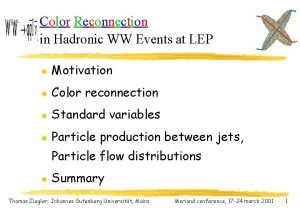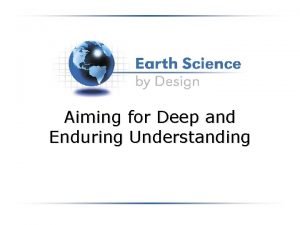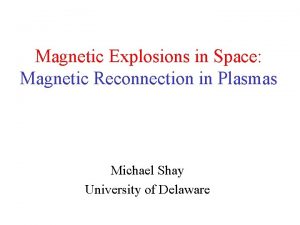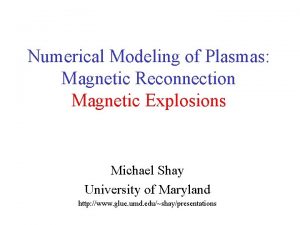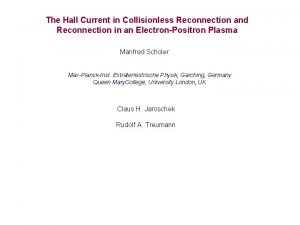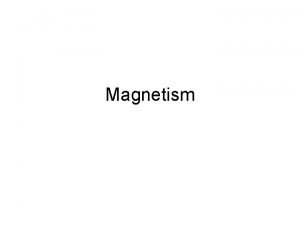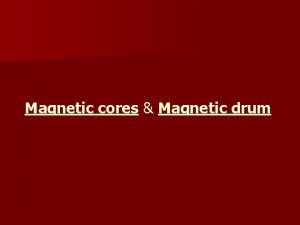Understand the Many Facets of Magnetic Reconnection Chang











- Slides: 11

Understand the Many Facets of Magnetic Reconnection Chang Liu NJIT. SWRL. 2010. 03. 10

Content SXR (based on cartoon by G. Holman) looptop footpoints photospheric magnetic fields EUV HXRs Hα flare ribbons lower atmosphere Using dynamics of flare ribbon and hard X-ray emission to study: 1. Electron acceleration 2. Two-stage magnetic reconnection * Current status of film digitization 3. In a larger-scale: successive flares/CMEs 4. Sunspot motion: response of photospheric magnetic fields

1. Analyses of ribbon dynamics and the HXR spectrum have been carried out separately. We have directly compared physical quantities derived from observations to bridge the research of magnetic reconnection and electron acceleration. Under a simplified model (Forbes & Priest 1984), The <E> defined may be able to represent the overall strength of reconnection electric field at the RCS. The X-ray spectrum is measured for the entire flaring region on the solar disk, thus the derived spectral index <γ> reflects the overall hardness of flare X-ray emissions.

Liu & Wang 2009, Ap. J, 696, L 27 (1) A larger electric field in the RCS corresponds to a harder HXR and presumably to a harder electron precipitation spectrum, which is qualitatively consistent with the trend predicted by numerical simulations. (2) Larger electric field strength may be responsible for stronger electron acceleration and hence stronger high-energy emissions seen in flares with larger magnitude. These are probably the clearest direct observational evidence obtained so far in favor of the hypothesis that direct acceleration by the electric field generated by magnetic reconnection may play an important role in producing energetic electrons in flares.

2. Two-stage Magnetic Reconnection Liu, Lee, Yurchyshyn et al. 2007, Ap. J, 669, 1372 Footpoints-to-ribbon & Sigmod-toarcade transformation Further observational signatures includes: v Contracting-to-separation development and strong-to-weak shear change of flare ribbons in Hα and UV/EUV (e. g. , Ji et al. 2006, Veronig et al. 2006, Su et al. 2007) v Temporal behavior of HXR footpoints pair (Xu et al. 2010)

Event under study: 2005 January 15 X 2. 6 (1) Enhancement of transverse fields along NL (2) Dynamics of HXR footpoints appear in two stages, with the latter one co-temporal with the main HXR peak. (3) Remote brightenings appear mostly in the first stage.

3. In a Larger-scale: Successive Flares and CMEs 2005 Sep 13 AR 10808: Four Flares + Double CMEs Liu, Lee, Karlicky et al. 2009, Ap. J, 703, 757

Event under study: 2005 January 15 X 2. 6 Overall, three appears three episodes of flare emissions. There are two extra HXR peaks later in the event, showing a smooth east-to-west migration of HXR sources. Magnetic reconnection in one part of AR causes subsequent separate reconnection in another part of AR fields. The linkage between them might be interesting and could reveal the complexity of magnetic topology.

4. Sunspot Motion – Response of Photospheric Magnetic Fields to Flares/CMEs Liu et al. 2010, in prep Penumbral decay is also obvious. The anisotropic seismic wavefront (Kosovichev 2006) seems to be consistent with the sunspot motions. Example: 040716 X 3. 6


• There appears a correlation between the kinetic energy associated with the sunspot displacement and the 6 m. Hz seismic energy, which favors the suggestion by Hudson et al. (2008) that sunspot displacement could potentially serves as an alternative excitation mechanism of seismic waves. • There appears moderate to good correlation (≥ 0. 51) between both the kinetic energy of sunspot displacement and the seismic energy at 6 m. Hz to the CME speed. • These could further provide rational support to the back-reaction mechanism during flares/CMEs, in the sense that the magnitude of this back-reaction (e. g. , sunspot displacement, seismic waves) might be related to how violent the coronal magnetic field is disrupted.
